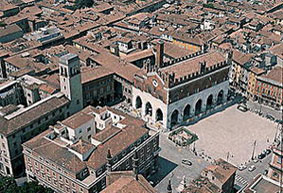


All the structures

Piacenza was founded on the right bank of the River Po, where the most important communication routes of the southwest Po valley meet. In 1848 it was the first city to unite with the Kingdom of Sardinia to become “the first-born of the Unification of Italy ".
Piacenza was founded as a Roman colony in 218 BC as the city’s layout demonstrates.
Piacenza’s period of greatest importance came after the year 1000, when it established itself as a thriving city in artistic and economic terms due to its strategic position as a trading point on the Via Francigena. The city was enhanced with works of art, such as the Cathedral in 1122 and the Gothic Palace in 1281.
The city’s most visited artworks are the Farnese Equestrian Statues, the work of the Tuscan sculptor Francesco Mochi from Montevarchi (1580-1654).
The sculptor took sixteen years to complete the work.
Piacenza, a city of art in Emilia Romagna, is known for its theatres: the Municipal Theatre, the Teatro dei Filodrammatici, the San Matteo Theatre etc. which present highly successful, quality performances.
Visit Vigoleno in the Piacenza province, a small town dotted with vineyards and woods.
The story of Vigoleno is documented in a photo exhibition on show in the castle keep. Also visit the castle tower from 1746, known to Piacenza’s citizens as the ‘Vigoleno Midday Meridian’.
In the sixteenth-century Piazza della Fontana an external barrel vault can be seen, once the ice-room connected to the castle and used for food preservation.
Also visit the town of Cortemaggiore in the Piacenza province, which has profited from the proximity of two major communication routes: the Via Aemilia and the Po. While in Cortemaggiore, admire the Collegiate Church of Santa Maria delle Grazie, the Church of the Santissima Annunziata, San Giovanni and the Palazzo Pallavicino.